The Swan Chair, designed by Danish icon Arne Jacobsenwhich in 1958, is one of history’s most iconic pieces of furniture. Designed in Jacobsen’s garage, it was created from a moulded shell placed over an aluminium swivel base, and upholstered in fabric or leather.
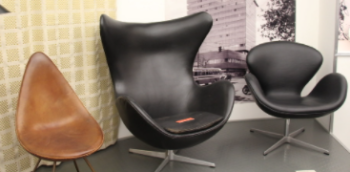
Image source:https://search.creativecommons.org/photos/2ebc087c-1bfd-485b-a179-370673ec800a by corno.fulgur75
Technological Innovation
The Swan, made and produced by the Republic of Fritz Hansen, has been in constant production since it was first designed, awing the public for what was, at the time, unseen technologically innovation for the time, as the chair uniquely presented no straight lines. Such is the chair’s popularity, that when the designer Paul Smith launched his new fabric design line, Point, he chose to have it cover a Swan chair. Aside from the lining material, the design of the Swan has changed very little over the years, and this air of being an almost unique art piece is reinforced by the serial numbers, each unique for every exemplary, adorning the chair, distinguishing it from a copy as well; it is no coincidence, after all, that his furniture is among the most copied in the world.
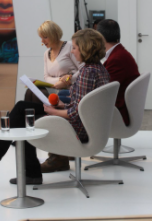
Image source: https://search.creativecommons.org/photos/2b83c552-c03e-40b4-bba8-f1feccf1f857 by smowblog
History
The Swan Chair was designed for lobby and lounge areas, specifically tailored for the Royal Hotel in Copenhagen, in 1958, much like its design peer, the famous Egg chair. It’s hard to say when the leap into the residential market was made, but it’s always been a product that seems to blur the line between contractual and residential, resulting in a very versatile, sculptural design with potentially timeless qualities- likely what attracted homeowners all over Europe.
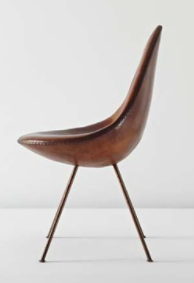
Image source: https://search.creativecommons.org/photos/c3ea5c64-6bcc-4f71-8256-64c9393076f3 by bianca.maggio
As one of the first chairs produced under the aegis of “Organic Modernism”, the foam molded frame of the Swan made its mark in design history. The first Swan chairs were based on a wooden frame and then upholstered with springs, natural fibers, fabric etc. But Jacobsen, embracing true modernism, was always open to new technological solutions, and so the avant-garde manufacturing method of the Swan left its footprint, right at the start of the modern furniture-making era.
The process of making a Swan chair spans many days, because the leather has to be wetted and dried first to get the right shape for of the Swan shell; afterwards, many hours are spent into the upholstery process. The mold itself and base are realized by machines, but all of the upholstery (cutting, gluing, stitching) and soft foam work (cutting and gluing) are by hand.
Arne Jacobsen (1902–1971)
Jacobsen began training as a mason, before studying at the Royal Danish Academy of Fine Arts in Copenhagen, where he won a silver medal for a chair competition, whose design was then exhibited at the 1925 Exposition Internationale des Arts Decoratifs in Paris. Influenced by Le Corbusier, Gunnar Asplund and Ludwig Mies van der Rohe, Jacobsen embraced a functionalist approach to design from the outset. He was among the first to introduce modernist ideas to Denmark and subsequently create industrial furniture that merged its technological prowess with the country’s craft-based design heritage.
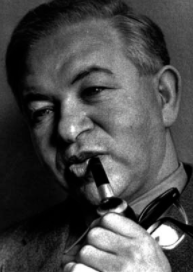
Image source: https://en.wikipedia.org/wiki/Arne_Jacobsen#/media/File:Arne_Jacobsen_photo.jpg
First among Jacobsen’s important architectural commissions was the Bellavista housing project in Copenhagen (1930-1934). His best-known works are the SAS Air Terminal and the Royal Hotel Copenhagen, for which Jacobsen designed every detail, from sculptural furnishings such as his elegant Swan and Egg Chairs (1957-1958) to textiles, lighting, ashtrays and cutlery.
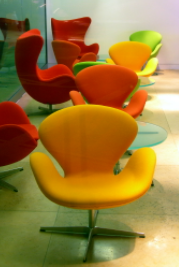
Image source: https://search.creativecommons.org/photos/966719de-b3c5-43fe-b0ba-9e79b67dfe41 by Lars Plougmann
During the 1960s, Jacobsen’s most important work was a unified architectural and interior design scheme for St. Catherine’s College, Oxford, which, like his earlier work for the Royal Hotel, involved the design of site-specific furniture. Jacobsen’s work remains appealing and fresh today, combining free-form sculptural shapes with the traditional attributes of Scandinavian design, material and structural integrity.

Image source:https://search.creativecommons.org/photos/d3bc7697-e9ab-4201-82eb-6ebde7d5bd88 by Steve Bellamy
The History of Fritz Hansen
Founded in 1872 in Denmark, Fritz Hansen is one of the world’s most recognizable producers of design furniture, aimed at both public and private spaces. The company’s history is characterized by meticulous craftsmanship, unique designs, and a sense of understated elegance. Leading architects and furniture designers from all over the world have produced timeless pieces for the company’s collection, which embraces innovative techniques and new materials. Contributors include legendary designers such as Arne Jacobsen, Poul Kjaerholm, Bruno Mathsson, Piet Hein, and Piero Lissoni as well as young innovators like Kasper Salto, Jaime Hayon, and Todd Bracher.
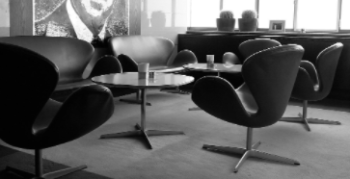
Image source:https://search.creativecommons.org/photos/859a5ad4-f769-4b89-8142-6cbb56fc5eee
Today, Fritz Hansen furniture is embraced by a range of global consumers from city dwellers to business executives who celebrate the company’s ability to enlighten and delight with design. Fritz Hansen products can be seen around the world in residences and high-profile corporations, luxury hotels and art centers including the famed SAS Royal Hotel in Copenhagen and the Museum of Modern Art (MoMA) in New York.
Data Sheet
Designer: Arne Jacobsen
Year: 1958
Manufacturer: Fritz Hansen
Materials: Fiberglass-reinforced, polyurethane foam shell; satin-chromed steel swivel; injection-molded aluminum base; fabric or leather upholstery.
Dimensions: H 77 cm W 74 cm D 68 cm Seat H 40 cm
Info sources:
https://fritzhansen.com/en/products/lounge-chairs/3320_swan_fabric
https://www.ft.com/content/f6594a2e-8ccf-11e3-ad57-00144feab7de
http://www.dwr.com/designer-arne-jacobsen?lang=en_US
https://midwesthomemag.com/home-dish-blog/a-visual-history-of-arne-jacobsens-midcentury-designs/
